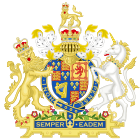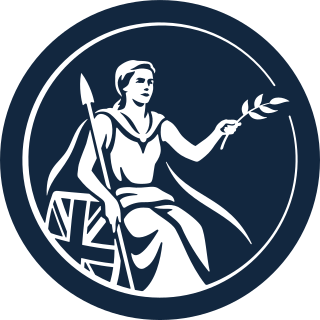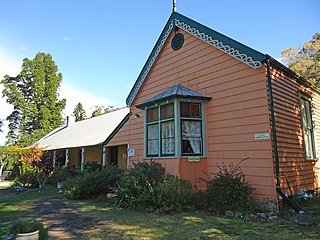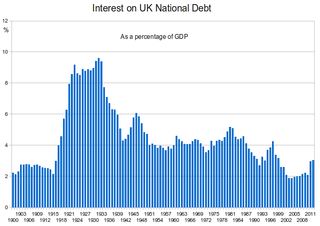Banking operations
The Hollow Sword Blade Company was sold and moved to Birchin Lane in London, to the premises of its new company secretary, John Blunt, a scrivener (lawyer specialising in business and financial contracts). The sale was probably arranged by Francis Child, whose son was a banker and business associate of Blunt. [8] The new Governor was Elias Turner, a goldsmith with a shop in Lombard street under the sign of the Fleece, who provided both finance and experience. The deputy Governor was Jacob Sawbridge, who came from a business family and who had a small estate in Canterbury. The fourth partner, George Caswall, came from Leominster which his family had represented as MP for generations. His father had been Mayor, and Receiver of the land tax for Monmouthshire. Caswall was a partner with another goldsmith, Brassey, specialising in finance and trading securities. Daniel Defoe described them: "Sawbridge is as cunning as Caswall is bold, and the reserve of the one with the openness of the other makes a complete Exchange Alley man. Turner ... acts in concert ... and makes together a complete triumvirate of thieving". (Exchange Alley was the place where stock trading and other financial transactions took place in London.) The objective of the partnership was to break into the business monopolised by the Bank of England, which was handling and providing loans for the government.
| Estate in Ireland of the Company for making Hollow Sword Blades in England Act 1703 | |
|---|---|
| Act of Parliament | |
 | |
| Long title | An Act to discharge the Governor and Company for making hollow Sword Blades in England, of the Sum of Eighteen Thousand Eight Hundred Sixty-four Pounds, Seven Shillings, One Penny Half-penny, by Mistake overcharged in the Purchase-money for several forfeited and other Estates and Interests in Ireland, purchased by them. |
| Citation | 2 & 3 Ann. c. 21 (Ruffhead: c. 12) |
| Dates | |
| Royal assent | 24 February 1704 |
| Other legislation | |
| Repealed by | Statute Law Revision Act 1867 |
Status: Repealed | |
In 1703 the company purchased some of the Irish estates forfeited under the Williamite settlement in counties Mayo, Sligo, Galway, and Roscommon. They also bought the forfeited estates of the Earl of Clancarty (McCarthy) in counties Cork and Kerry and of Sir Patrick Trant in counties Kerry, Limerick, Kildare, Dublin, King and Queen's counties (Offaly and Laois). Further lands in counties Limerick, Tipperary, Cork and other counties, formerly the estate of James II were also purchased, also part of the estate of Lord Cahir in county Tipperary. In June 1703 the company bought a large estate in county Cork, confiscated from a number of attainted persons and other lands in counties Waterford and Clare. However within about 10 years the company had sold most of its Irish estates. Francis Edwards, a London merchant, was one of the main purchasers. [9]
The recent reconquest of Ireland by forces loyal to William III had resulted in the confiscation of land from Jacobites which had been given to members of the Williamite army. Blunt was amongst others who campaigned that the property should instead have been sold to defer government expenses, and an act of parliament was passed cancelling the grants of land which instead were to be sold. The Sword Blade company now used its charter powers to own property to purchase land to the value of £200,000 with anticipated revenues of £20,000 per year, or 10%. To pay for this, the company used a trick which the Bank of England had employed in its own creation. The Hollow Sword Blades Company issued shares, which it was also entitled to do under its charter. It offered to exchange its own shares at a nominal value of £100 for £100 of government debt issued by the army paymaster. The government was willing to accept its own debt as payment for the land, so no cash money was required for the transactions. The army debt could at that time only be sold on the open market at a rate of £85 per £100 of face value, so this offered a way for holders to realise a better price. The land remained the property of the company, and the company would pay dividends on the shares from its rental income.
The deal was negotiated with the treasury by Blunt and their legal advisor, Lake and agreed on 1 June 1704. Once the debt was cancelled, the government no longer had to pay interest upon it, which it had been doing at 7.5%. However, it also required a 'sweetener' in the form of receiving a new loan of £20,000 at 5% as part of the deal, secured against Royal shares in Cornish tin.
Before announcing the offer, the Sword Blade Syndicate made full advantage of the anticipated rise in value of army debt, by buying as much as it could privately beforehand. This was then sold as the price rose once the general market realised there was an offer available to trade in the debt at its full value. [10]
The Sword Blade company also branched out into providing mortgages for other would be purchasers of Irish land, accepting cash deposits and issuing its own notes. This came to the attention of the Bank of England, who advised the treasury that their own monopoly to act as a bank was being infringed. The treasury took no action. In part, the government recognised that it had a good deal it did not wish to spoil. There was also a legal complication, that the Bank act protected it against any other company being set up by act of parliament to operate as a bank. In the case of the sword company charter, although the steps to enact its charter had been commenced, they had never actually been completed in Parliament. [11]
The Bank of England charter was due to expire in 1710, and they were concerned to arrange its renewal. Others, however, continued to lobby Parliament not to do so, and a new syndicate had formed, offering to take on funding of the latest loan required by government. The Bank responded by dropping its interest rate to underbid the competition, and succeeded in renewing its charter until 1732, with more strictly drawn terms to prevent others operating as banks.
| Forfeited Estates Act 1707 | |
|---|---|
| Act of Parliament | |
 | |
| Long title | An Act for limiting a Time to Persons to come in, and make their Claims to any of the forfeited Estates, and other Interests in Ireland, sold by the Trustees for Sale of those Estates to the Governor and Company for Making Hollow Sword-Blades in England, and divers other Purchasers. |
| Citation | 6 Ann. c. 61 Ruffhead c. 34 |
| Dates | |
| Royal assent | 1 April 1708 |
| Other legislation | |
| Repealed by | Statute Law Revision Act 1867 |
Status: Repealed | |
Further complications faced the Sword Blade company, as title to land in Ireland began to be disputed by relatives of dispossessed Jacobites and others claiming to have bought from the initial beneficiaries of the first cancelled land distribution. The matter was settled by an act of parliament in 1708 (Forfeited Estates Act 1707, 6 Ann. c. 61) setting a time limit on further claims, but by then the company stock had fallen to £55 per nominal £100 issued. As some consolation, pressure was also mounting on the Bank of England from an increasingly distressed government seeking new ways to raise money. [12]











